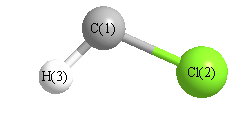Jump to
S2C1
Energy calculated at HF/cc-pVQZ
| | hartrees |
|---|
| Energy at 0K | -497.860758 |
| Energy at 298.15K | -497.860635 |
| HF Energy | -497.860758 |
| Nuclear repulsion energy | 38.832394 |
The energy at 298.15K was derived from the energy at 0K
and an integrated heat capacity that used the calculated vibrational frequencies.
Geometric Data calculated at HF/cc-pVQZ
Point Group is Cs
Cartesians (Å)
| Atom |
x (Å) |
y (Å) |
z (Å) |
|---|
| C1 |
0.044 |
1.189 |
0.000 |
| Cl2 |
0.044 |
-0.505 |
0.000 |
| H3 |
-1.015 |
1.447 |
0.000 |
Atom - Atom Distances (Å)
| |
C1 |
Cl2 |
H3 |
| C1 | | 1.6936 | 1.0906 |
Cl2 | 1.6936 | | 2.2208 | H3 | 1.0906 | 2.2208 | |
 More geometry information
More geometry information
Calculated Bond Angles
| atom1 |
atom2 |
atom3 |
angle |
|
atom1 |
atom2 |
atom3 |
angle |
| Cl2 |
C1 |
H3 |
103.690 |
|
Electronic energy levels
Charges, Dipole, Quadrupole and Polarizability
Charges from optimized geometry at HF/cc-pVQZ
Charges (e)
| Number |
Element |
Mulliken |
CHELPG |
AIM |
ESP |
| 1 |
C |
-0.109 |
|
|
|
| 2 |
Cl |
-0.002 |
|
|
|
| 3 |
H |
0.110 |
|
|
|
Electric dipole moments
Electric dipole components in Debye
(What's a Debye? See section
VII.A.3)
| |
x |
y |
z |
Total |
| |
-1.552 |
-0.230 |
0.000 |
1.569 |
| CHELPG |
|
|
|
|
| AIM |
|
|
|
|
| ESP |
|
|
|
|
Electric Quadrupole moment
Quadrupole components in D Å
| Primitive |
|---|
| | x | y | z |
|---|
| x |
-19.649 |
-2.891 |
0.000 |
| y |
-2.891 |
-19.926 |
0.000 |
| z |
0.000 |
0.000 |
-18.208 |
|
| Traceless |
|---|
| | x | y | z |
|---|
| x |
-0.582 |
-2.891 |
0.000 |
| y |
-2.891 |
-0.998 |
0.000 |
| z |
0.000 |
0.000 |
1.580 |
|
| Polar |
|---|
| 3z2-r2 | 3.160 |
|---|
| x2-y2 | 0.277 |
|---|
| xy | -2.891 |
|---|
| xz | 0.000 |
|---|
| yz | 0.000 |
|---|
|
Polarizabilities
Components of the polarizability tensor.
Units are
Å
3 (Angstrom cubed)
Change units.
| |
x |
y |
z |
| x |
3.076 |
-0.173 |
0.000 |
| y |
-0.173 |
4.956 |
0.000 |
| z |
0.000 |
0.000 |
2.878 |
<r2> (average value of r
2) Å
2
| <r2> |
28.011 |
| (<r2>)1/2 |
5.293 |
Jump to
S1C1
Energy calculated at HF/cc-pVQZ
| | hartrees |
|---|
| Energy at 0K | -497.885338 |
| Energy at 298.15K | -497.885206 |
| HF Energy | -497.885338 |
| Nuclear repulsion energy | 38.797574 |
The energy at 298.15K was derived from the energy at 0K
and an integrated heat capacity that used the calculated vibrational frequencies.
Geometric Data calculated at HF/cc-pVQZ
Point Group is Cs
Cartesians (Å)
| Atom |
x (Å) |
y (Å) |
z (Å) |
|---|
| C1 |
0.036 |
1.162 |
0.000 |
| Cl2 |
0.036 |
-0.515 |
0.000 |
| H3 |
-0.831 |
1.790 |
0.000 |
Atom - Atom Distances (Å)
| |
C1 |
Cl2 |
H3 |
| C1 | | 1.6774 | 1.0703 |
Cl2 | 1.6774 | | 2.4627 | H3 | 1.0703 | 2.4627 | |
 More geometry information
More geometry information
Calculated Bond Angles
| atom1 |
atom2 |
atom3 |
angle |
|
atom1 |
atom2 |
atom3 |
angle |
| Cl2 |
C1 |
H3 |
125.899 |
|
Electronic energy levels
Charges, Dipole, Quadrupole and Polarizability
Charges from optimized geometry at HF/cc-pVQZ
Charges (e)
| Number |
Element |
Mulliken |
CHELPG |
AIM |
ESP |
| 1 |
C |
-0.097 |
|
|
|
| 2 |
Cl |
-0.032 |
|
|
|
| 3 |
H |
0.129 |
|
|
|
Electric dipole moments
Electric dipole components in Debye
(What's a Debye? See section
VII.A.3)
| |
x |
y |
z |
Total |
| |
-0.635 |
0.861 |
0.000 |
1.070 |
| CHELPG |
|
|
|
|
| AIM |
|
|
|
|
| ESP |
|
|
|
|
Electric Quadrupole moment
Quadrupole components in D Å
| Primitive |
|---|
| | x | y | z |
|---|
| x |
-18.563 |
-1.300 |
0.000 |
| y |
-1.300 |
-16.839 |
0.000 |
| z |
0.000 |
0.000 |
-19.630 |
|
| Traceless |
|---|
| | x | y | z |
|---|
| x |
-0.329 |
-1.300 |
0.000 |
| y |
-1.300 |
2.258 |
0.000 |
| z |
0.000 |
0.000 |
-1.929 |
|
| Polar |
|---|
| 3z2-r2 | -3.857 |
|---|
| x2-y2 | -1.725 |
|---|
| xy | -1.300 |
|---|
| xz | 0.000 |
|---|
| yz | 0.000 |
|---|
|
Polarizabilities
Components of the polarizability tensor.
Units are
Å
3 (Angstrom cubed)
Change units.
| |
x |
y |
z |
| x |
2.801 |
-0.153 |
0.000 |
| y |
-0.153 |
4.566 |
0.000 |
| z |
0.000 |
0.000 |
2.639 |
<r2> (average value of r
2) Å
2
| <r2> |
27.998 |
| (<r2>)1/2 |
5.291 |
